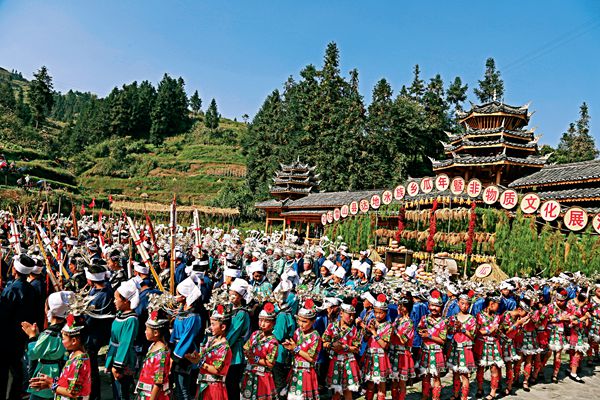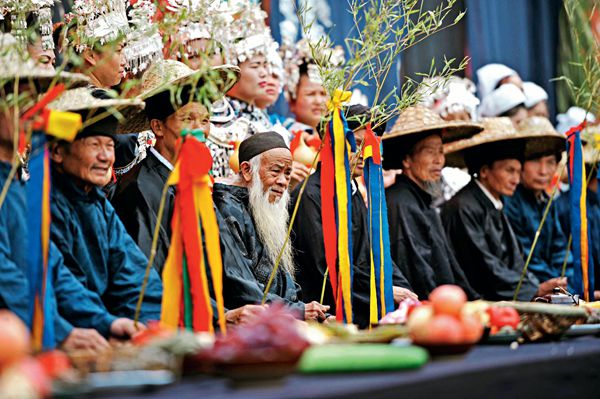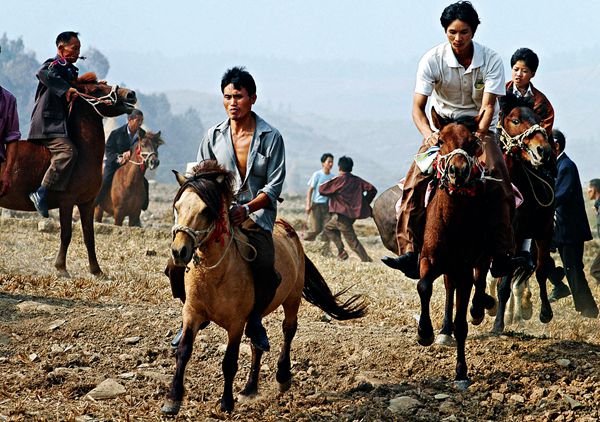Duan Festival: The World’s Longest Festival
PEOPLE of the Shui ethnic group, with a total population of about 340,000, mainly live in southern and southeastern Guizhou Province. A small number also live in western Guangxi Zhuang Autonomous Region.
Engaging mainly in agriculture, the Shui people have developed their own language, both oral and written, and a special calendar. The Shui calendar divides the year into four seasons and 12 months, basically in line with the traditional lunar calendar widely used in China. The biggest difference is that the year of the Shui calendar starts with the ninth Chinese lunar month and ends with the eighth.

Villagers dressed in traditional costumes celebrate the Duan Festival.
The Duan Festival is the Shui New Year celebration, starting from the 12th month of the Shui calendar, or the eighth month of the lunar calendar. Their grandest festival, it lasts 49 days, to accommodate as many as seven branches of the community’s celebration of the festival. The seven (once nine) branches follow a fixed order of celebration, which must be strictly followed.
The Duan Festival celebrates harvest and also makes offerings to ancestors. In 2006, the Duan Festival was listed in the first group of China’s National Intangible Cultural Heritage List.
Traditions
The origins of the Duan Festival closely relate to the history of the Shui. They used to live in Guangdong Province and Guangxi Autonomous Region, but for some reason had to move northward. Following a leader named Gong Deng, they eventually settled in Sandu (now a Shui autonomous county). Different branches of this community spread around the Sandu area, and promised to meet three years later.

The Duan Festival was listed in the first group of China’s National Intangible Cultural Heritage List in 2006.
At the end of the third year, everyone returned to Gong Deng’s house, bringing with them crops, vegetables, and fruits. They sang, shared food and drink, and beat drums, celebrating their reunion and their new lives. They then made it a convention to gather together and celebrate at the end of each year. Gradually this became the Duan Festival annual gathering.
As the festival nears, the whole county is infused with excitement and joy. Each household is busy with preparations – thorough cleaning of homes, pounding of rice, making rice wine, grinding tofu, and catching fish.
On New Year’s Eve, family members gather for reunion dinners and the solemn ritual of revering ancestors. On a square dinner table, tableware is placed for each member of the family, but the total settings should be an odd number. Close to the shrine are placed a plate of “fish stuffed with leeks,” one of sticky rice, and several of fruits. Eight empty chairs are placed around the table, awaiting the return of the souls of ancestors.
When everything is prepared, all family members sit together to enjoy dinner. Youngsters and children in groups then visit each house to ring in the New Year by beating drums hung in the courtyard.
Around midnight, the eldest male in the family leads all members to enjoy the food offered to ancestors, and replenishes cups with wine and tea as new offerings. The eldest female in the family sets a special offering table by the staircase for souls with nowhere to go or “hungry ghosts,” allowing the children to enjoy these offerings.
Early morning on New Year’s Day, elders of the family first taste those food offerings. Then freshly cooked fish stuffed with leeks and sticky rice are placed on the altar, and cups are refilled with tea and wine. The whole house brims with a festive atmosphere.
Fish Stuffed with Leeks
According to the Duan Festival tradition, vegetarian dishes are served on New Year’s Eve and New Year’s Day until the horse race is over. The exception, however, is fish stuffed with leeks, which is also a must for offerings as well for serving guests.
Fish stuffed with leeks is the most famous Shui dish. Each family prepares as much as 30 to 50 kg of fish for the Duan Festival. It is said that this dish is to pay tribute to ancestors who had little food during their long migration.
Cooking this fish is delicate work. First the fish is cut into two, the insides cleaned, and red chili, leeks and guangcai (a wild vegetable) are placed inside. Then the two halves are put together and wrapped in straw. The fish can be stewed, steamed, or braised, the last the most popular method.
The leeks and guangcai are put at the bottom of a ceramic urn, and then a layer of chilies, followed by a layer of fish, with some homemade rice wine sprinkled on the fish. This entire layering process is repeated until the pot is full, and a wooden or bamboo lid is then placed over it.
At the same time, a big iron wok is readied on the stove. It is filled with water, some seasoning is added, and a wooden frame is placed in the wok. The urn is placed on the frame, and the wok and urn are covered by a wooden barrel. It takes about 12 hours to complete the braising.
Wild leeks are also considered a common medicinal ingredient by the Shui, mixed with other herbs, to treat such traumas as fractures, bleeding, bruises, and other injuries. Another remedy is to chop wild leeks and stew them with egg to kill roundworm. Containing Vitamin A, calcium, phosphorus, iron, and high in cellulose, wild leeks can regulate and stimulate the stomach, while stimulating the appetite. Along with the nutritional value of the fish itself, fish stuffed with leeks is a very healthy dish.
Horse Racing
The horse race, the climax of the Duan Festival, is held after lunch on New Year’s Day.
The event always takes place on a chosen hillside, which is called the Duan Slope or New Year Slope. People from every village flock to it, making the race a great opportunity for romance.

The horse race is the climax of the Duan Festival.
A simple ancestor worshiping ritual is held before the horse race. It is performed by a respected elder who, holding a full cup of wine, prays for a safe race as well as good weather and harvests in the new year. After the ritual, the elder mounts a horse and rides around, marking the start of the race.
The race is unique for its “jostling.” When the starting gun goes off, dozens of horses race forward at the same time to the top of the slope. The riders spur their horses with whips, accompanied by cheers and applause from the onlookers. There are no judges appointed for the race; instead, everyone is the judge. They all hail the rider that is fastest and best, and regard him as the hero of the day.
After the race, friends and relatives return home to enjoy fish stuffed with leeks. It is a sleepless night full of drinking, dance, song, and the beating of drums everywhere. This joyous and harmonious atmosphere lasts for the entire festive period.
The Duan Festival, with its distinctive folk features, is the world’s longest. The horse race is a unique traditional event for the Shui people, rarely seen in other parts of the country. Many other such festive activities as the bullfighting dance, drum dance and antiphonal singing add even more color to the festival.
(Compiled by China Today)
